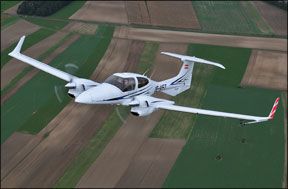The NG in Diamonds new diesel-powered DA42 NG presumably means “next generation,” but it could just as we’ll stand for never-ending guts, for thats what it took to bring this airplane to life. When, four years ago, Diamond certified the original DA42 with Thielert diesel engines, we considered it a bold move indeed. Following up that ill-starred project with a new model equipped with an engine Diamond certified itself strikes us as off-scale nervy, but thats what the DA42 NG represents. To be accurate, the diesels in the NG werent developed by Diamond, but by Austro, an independent company brought to life by Diamond principle Christian Dries. The new state-of-the-art engine factory is right next door to Diamonds Wiener-Neu-stadt factory located south of Vienna. The Austro engines exist because Dries and Diamond were unhappy with the service history of the original Thielert diesels and even more unhappy with Thielerts slow response in fixing the significant technical shortcomings those engines developed in the field. In record time, Austro certified the new AE300 and is now shipping it. The engine appears to be more efficient, it develops more power, but is also heavier than the original Thielert engines were. The large and unanswerable question is this: Will these engines deliver reasonable reliability and acceptable service history? we’ll know in a year or two; in the meantime, here are our impressions of the Austro-powered DA42 NG.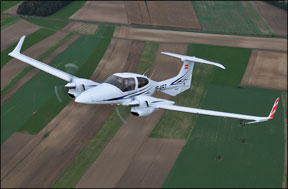
From Auto to Air
Both the Thielert-now Centurion-and Austro AE300 share a common antecedent. They are both based on the 1.6 to 2.0 litre engines Mercedes developed for its popular A-class sedan. Mercedes has sold more than a million of these cars worldwide, although not all are diesel powered. Austro worked in conjunction with a Mercedes daughter company, MBtech, to adapt a powerplant meant for the highway to one suitable for airplanes.
Converting auto engines for aircraft use has rarely been a painless process and there are no commercial examples in GA. Car engines are typically heavier than aircraft engines of equivalent power and if theyre water cooled, radiators and plumbing aggravate the weight differential.
Next to weight, a perennial sticky point in converting auto engines is the need to reduce engine RPM-typically about 3500 to 4000-to a more prop-friendly 2400 RPM. This requires a gearbox, meaning yet more weight. RPM aside, diesels have another problem: Their sharp power pulses send torsional spikes down the driveline from the crankshaft, causing all sorts of wear and fatigue issues if not tamped down.
This is where Thielert ran into trouble. To isolate the crankshaft torsionals from the gearbox and prop, it used a conventional automotive clutch design, to provide pulse-absorbing slippage between the crank and the gearbox. Although light, the clutch proved to be a maintenance headache, requiring frequent inspection and
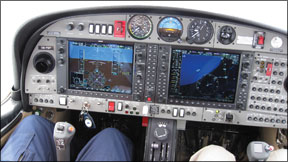
replacement, especially of the springs in the clutch plate.
The gearbox itself also proved a weak point. When Thielert introduced the engine in 2004, it proposed a 300-hour inspection interval on the gearboxes until the engine proved itself. For inspection, the gearbox has to be removed and disassembled, often involving a trip to Germany. Five years later, the reorganized Thielert-now called Centurion-is still promising a longer inspection interval and its not at all clear what the hold-up is.
Evidently, Diamond foresaw the shortcomings of the Thielert diesels a year or so into the DA42 program. Although no one at Diamond has said as much, the company seems to have anticipated Thielerts footdragging on improvements, for it launched the Austro certification effort about three years ago, yielding a fully certified engine last spring. In July, the FAA rubber stamped the EASA certification and the AE300 is now an FAA-certified engine. Approval for the DA42 NG is expected later this year.
The Austro differs from the Thielert by both degree and philosophy. When it converted the MB engine, Thielert made significant modifications in the name of weight reduction and performance. Among them was recasting the original cast iron block in aluminum and modifying the head, injector system and valve train. Other features of the engine-the FADEC and subsidiary systems such as prop and turbocharger controls and the clutch and gearbox-were developed in-house by Thielert.
From testing and field service, Austro evidently concluded that in making such significant modifications to the engine, Theilert gave up the economy of scale and large-volume quality control that MB so expensively engineered into the engine in the first place. Further, early service history suggested that Thielerts gearbox and clutch arrangement simply wasnt robust enough to survive the rigors of the flight environment.
So Austro stuck with MBs original cast iron block and valve train and engaged Bosch to build a purpose-designed fuel injection system for the AE300. Bosch, which set up a dedicated general aviation products unit, also designed and built the AE300s FADECs. The injection system runs at a high common rail pressure of about 23,000 PSI (1600 bar), which is how Austro ekes out a little more fuel efficiency.
The engine does differ from the MB original in some ways. For example, the turbocharger is mounted high on the engine rather than below the cylinder head and numerous accessory modifications were made. It has a 28-volt alternator, a top-mounted oil filter and a modified sump.
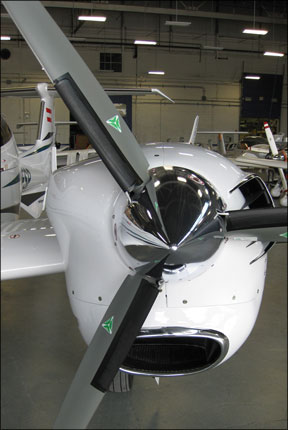
What may be the most critical modification is the gearbox and torsion vibration damper. The gearbox is physically larger and beefier looking than the unit Thielert developed and Austro says the gear engagement surfaces are almost twice as large. The torsional damper is installed on the flywheel between the crankshaft and the gearbox input shaft. It consists of a disc-within-a-disc design which absorbs torsional pulses through a pair of long-stroke springs.
For both the gearbox and torsional damper, Austro proposes a replacement/inspection cycle of 1000 hours, which is the initial proposed TBO of the engine. And that brings up another important difference between the Thielert/Centurion line and the Austro line: The AE300 is intended to be an overhaulable engine, not an engine replaced at the end of its service life. Cost of the overhaul is set initially at about $17,000 (12,000) or $17 per hour for a 1000-hour engine. By contrast, the current Centurion engine costs $43,000 (30,065) to replace for a 1200-hour engine. Thats $35 per flight hour. (See the companion articleat right for a detailed economic analysis.)
Austros use of the cast iron block, of course, exacts a weight penalty-112 pounds per side over the Thielert. Rather than put the airplane and engine on a diet, Diamond simply certified the NG to a higher weight of 4180 pounds, versus 3935 pounds for the original DA42. The NG thus has about a 20-pound higher useful load.
“It was easier to certify the higher weight than it was to build the engine down to a lower weight,” Diamonds North American CEO, Peter Maurer, told us.
Same, But Different
Outwardly, there’s not much noticeable difference between the NG and its progenitor. When its pointed out, however, the engine cowls on the NG are larger and there’s a noticeable bulge for the turbocharger on the right side of each engine. The engines arent handed and both are clockwise turning, so the left engine is critical. A close look at the main landing gear reveals that its beefed up slightly to accommodate the higher gross weight, but the nosegear was unchanged.
Inside the aircraft, the throttle quadrant is a bit different than that used for the Thielert engines, but operation is still single lever-push them up to go faster, pull them back to go slower. Prop RPM and fuel flow are all handled automatically by the FADECs, with the results displayed on the Garmin G1000. Speaking of which, the G1000 obviously has new software to accommodate the Bosch FADECs and the display is, frankly, somewhat busy. There’s no CHT or EGT to monitor, but in place of that, there’s coolant temp, oil temps, fuel flow and, plus gearbox temp. It takes a concentrated look at the engine sidebar to sort everything out.
The NGs fuel system is the same as the DA42, with 50 gallons in two 25-gallon wing cells, plus two 13-gallon aux tanks in each nacelle behind the engine. Most airplanes are ordered with the aux tanks, since 50 gallons is shy for long-range flying, even with a diesel. Internal pumps move the fuel from the aux tanks into the mains and the system is equipped with auto sensing to keep from accidentally pumping fuel overboard. The G1000 annunciates the aux pumping function.
Feeding the engines are a pair of low-pressure pumps that deliver fuel to the high-pressure common rail pumps. In normal flight, only one of these pumps is running, but both are switched on manually for takeoff. (The Thielert engines didnt have these pumps.)
For electricals, the NG has a 28-volt alternator on each engine, plus a single ships starting battery. The FADECs live in the lower nacelle behind the engine, accessible via a large removable cover. As with the engine in general, theyre equipped with heavy duty mil-spec connectors, not the automotive grade hardware used in the Thielert airplane. A Diamond factory tech in London-who only recently laid eyes on the NG-said the FADECs were more easily accessible than in the previous model. Each FADEC is dual channel-the engine will run on either-and is equipped with a small keep-alive battery thats independent of the ships electrical system. This is the result of a lesson Diamond learned the hard way when a DA42 suffered a dual engine failure after takeoff because the FADECs packed up the engines after the voltage caved due to a low battery.
Flying It
We demod the DA42 at Diamonds London, Ontario plant with production test pilot Bill Scott. He did the flying, while we did the performance checking and note taking. When we flew the DA42 in Austria five years ago, we were impressed with
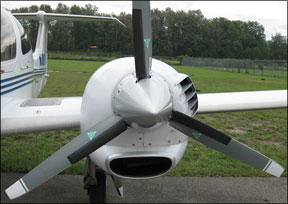
its ease of starting and the smoothness of the engines. The Austros deliver similar impressions. Rather than a flurry of mixture rich, throttle cracked and boost pumps humming, you simply flip on the engine master switch and bump the starter. We tried to count blades, but the engines seemed to start before a full rotation. After a whiff of diesel exhaust, they settle into a vibrationless idle.
Preflight engine checks are push-button automated. On an angled panel to the right of the pilots PFD are two momentary buttons labeled ECU Test. Holding them down runs the engine through checks of both channels of each FADEC, including a brief increase in power to check prop and power monitoring functions. When the FADECs swap channels, there’s a noticeable roughness that immediately smooths out. There’s also a toggle switch labeled Voter that allows the pilot to manual select or test each FADEC channel. After that, everything else is conventional. Check the trim and controls and the fuel valves and go.
Performance
Scott said the Austro-powered NG lacks the kick in the pants acceleration of the Lycoming-powered L360 DA42, but we cant honestly say the difference is that great. On a standard day, the NG needs 2405 feet of runway, while the Lycoming requires 2229. The Austros seem to have plenty of punch.
Climbing out, we saw numbers the POH said we should expect. With power set at 100 percent, the NG climbed on both engines at about 1200 FPM at a Vy of 86 knots. There’s a five-minute limit on 100 percent power, after which 92 percent is available for continuous use. This knocks about 150 FPM off the climb rate. FADEC scheduling allows 100 percent power to about 10,000 feet, after which it decreases linearly to 18,000 feet. To set power, you simply set the levers where you want them; the G1000 shows percent power directly.
In cruise performance, the NG bests the POH a little. At 4000 feet and 75 percent power, we noted 154 knots TAS on 6.6 GPH per side. Full power-92 percent continuous-yielded 167 knots TAS on 8.3 per side. Climbing to 12,000 feet, gave us 165 knots TAS on 6.6 GPH per side. Allowing for a 45-minute reserve, this allows a still-air range of 850 miles. Dialed back to a 55 percent max economy cruise, the NG tools along at 138 knots TAS on 4.7 GPH per side and the range increases to around 1000 miles, with 45 minutes reserve.
Throughout our trials, all of the engine parameters remained comfortably in the green, with the exception of the oil temperature, which rose into the yellow arc. Diamonds Scott says the London factory hasnt done enough testing to know if this was a sensor or baffling issue. Coolant temperature were on the high side of green.
Single-engine performance was as the book predicted. At 6000 feet, caging the left engine produced an initial sink rate, followed by a not-too-difficult to achieve 200 FPM climb on the right engine. Shutting one down and bringing it back is simple. Just idle it and flip the engine master off. It auto feathers and stops in about two seconds. To bring an engine back, flip the master on and bump the starter, then advance the throttle when the engine is warmed up. For unfeathering, the Austro has an oil-pressure accumulator.
Ergos, Payload
The NG we flew was lavishly appointed with leather seats and TKS-what Diamond calls the Platinum options. Its empty weight was 3253 pounds for a useful load of 927 pounds. With full fuel, there’s room for 418 pounds of bags and people, meaning its a two-person airplane with generous baggage or three people, light
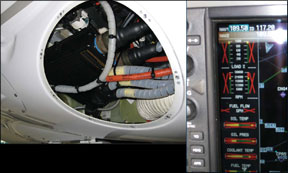
bags and down-fueled to four hours of endurance.
By direct comparison, the Lycoming-powered L360, at 2941 pounds empty, has 172 pounds more of useful load-about one persons worth. With three people in the L360, there’s room for bags and full fuel and an endurance of about 3 hours at 155 knots, leaned rich of peak. That gives a still-air range of 500 miles, with reserves. It will do better at economy settings but it wont outrange the NG.
The NG retains Diamonds signature wide cabin, with excellent visibility and good ventilation. Although we didnt need it, the NGs heating system draws from the each engines coolant circuit and runs heated air into a central manifold under the cabin floor. The back seat is easily accessible through a top opening hatch over the left wing. And once youre in it, its as comfortable and roomy as any airplane in this class.
Conclusion
In our view, the NG is more about economic performance than flight performance. Although it set no speed records, the Thielert-powered DA42 was adequate to the task as a multi-engine trainer and personal transportation machine with the safety of a second engine.
Where it failed was in promised reliability at a cost of operation its customers could afford. Thielert seems to have vastly underestimated both and when the engine tanked mechanically, the company couldnt support warranty claims and bankruptcy-from which it has not yet emerged-soon followed. Diamond wasnt in a position to back up Thielerts failed warranties.
Against that backdrop, we cant judge the NG yet. Our initial take is that Austros decision to more or less let the engines weight run wild will probably impact durability favorably. Its just a beefier engine and diesels may just need that weight. (One complaint about the SMA diesel-a design thats essentially gone nowhere-is that its too heavy.)
Diesels may also need to command an eye-opening purchase price. The NG certainly does. At $731,850, its getting up there with the Barons and the Mirages. Were not sure if the glamour of a Jet-A burning diesel will overcome that price barrier or not. Diamonds Peter Maurer told us that schools that purchase new airplanes are less concerned about capital costs than operating costs. If hes right and if the Austro can deliver good dispatch reliability and eventually a 2400-hour TBO on low operating costs, the NG could succeed where the Thielert-powered airplanes did not.
Well re-examine the subject in a couple of years, when Diamond has fielded enough Austros to accumulate some service history.

